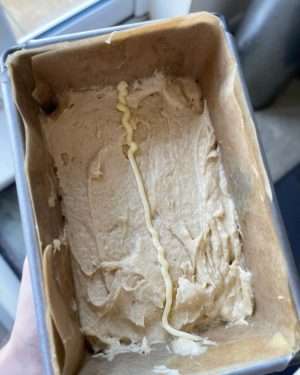Small Batch Lemon Drizzle
Super lemony, with a subtle nutty flavour. This makes a smaller loaf than most recipes, great for when you only need a couple of portions.
Servings: 6 People
Equipment
- 450g/1lb Loaf Tin
- Stand Mixer
- Piping Bag
Ingredients
Sponge
- 120 g Unsalted Butter 60g Browned, 60g Softened
- 80 g Golden Caster Sugar
- 20 g Light Brown Sugar
- 2 Lemons, Zested
- 2 Medium Eggs Lightly Beaten
- 100 g Plain Flour
- 20 g Ground Almonds
- 1 tsp Baking Powder
- 1 Pinch Table Salt
- 25 g Lemon Curd
- 2 tbsp Milk
Syrup
- 1 Lemon, Juiced
- Water To Make Lemon Juice Up To 75g
- 75 g Golden Caster Sugar
Icing
- 1 Lemon, Juiced
- 75 g Icing Sugar
Instructions
- Start by greasing & lining a 450g/1lb loaf tin.Preheat your oven to 180°c.
- Place the golden caster & light brown sugar into the bowl of a stand mixer. Add the lemon zest & massage into the sugars.
- Sift the flour & baking powder together into a bowl then add the ground almonds & salt. Whisk to combine then set aside.
- Add the brown butter & 50g of the softened butter (place the remaining 10g of softened butter into a piping bag & set aside) to the sugar & beat with the mixer’s paddle attachment until light & fluffy (3-4 minutes).Make sure to scrape down the sides of the bowl every couple of minutes.
- With the mixer at a medium speed, beat in the eggs a little bit at a time.
- Add half of the dry ingredients & the all of the lemon curd to the cake batter. Mix on a low speed until just combined. Add the remaining dry ingredients & the milk & mix to combine.
- Transfer the cake mix into the prepared loaf tin. Smooth the top of the cake mix with a spatula then pipe a thin line of softened butter down the centre of the tin.

- Bake the cake for 40-50 minutes until the cake is golden brown & a skewer comes out clean.
- Whilst the cake is baking, make the syrup.To do this, juice the lemon & weigh how much juice is produced. If necessary, top up with water so that you have 75g of liquid.Next, add the sugar & juice to a small saucepan & cook over a medium heat until the sugar has dissolved. Bring the syrup to a boil & reduce for 1 minute. Pass through a sieve & set aside to cool slightly.
- Once the cake has cooked, leave to cool until no longer hot but still slightly warm. Poke some holes into the top of the cake with a skewer then evenly pour over the warm syrup.Leave the cake to cool to room temperature then remove the cake from the tin (keep it in the baking paper) & wrap tightly with clingfilm. Leave overnight.
- The next day, unwrap the cake & place onto a cooling rack set over a baking tray. To make the icing, sift the sugar into a bowl & whisk in enough lemon juice to make a smooth, runny icing.Brush this all over the cake & leave to set before serving.
Notes
To Cook In An Aga.
Cook in the baking oven, on the bottom set of runners.
Kept in an airtight container, this cake will keep for 2-3 days.
Make sure that the sponge ingredients are all at room temperature before mixing (apart from brown butter).
Remember to set aside 10g of the softened butter in a piping bag. This will be used to pipe a line of butter down the centre of the sponge before cooking - This allows us to control where the cake will crack whilst baking.
Don’t worry if the cake mix appears to be curdled after you add the eggs, it’ll come back together when you add the dry ingredients.
Make sure to scrape down the sides of the mixing bowl regularly to ensure a smooth, evenly mixed cake batter.
Check the cake after it has baked for 35-40 minutes. If it is browning too quickly, loosely cover the top with a piece of foil.
Before juicing the lemons for the syrup & icing, microwave them for a minute. This will make them easier to juice.
